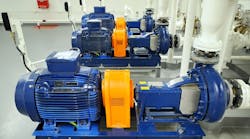An important question dawned upon me: “How is the caustic pump protected if the expansion joint at its suction port splits open?” That pump was the only one capable of keeping the plant running at full capacity. Thinking about this issue a bit more, I realized that many pumps in lots of plants I’d been to had little or no protection.
One of four culprits usually kill a pump: 1) a loss of flow from the feed tank caused by a suction line failure or a drop in tank level; 2) a blocked suction or discharge line; 3) a mechanical failure such as a broken shaft due to debris fed to pump, change in pumping fluid, corrosion, etc., or running a pump with a variable-speed drive (VSD) too fast or too slow; and 4) mis-application, e.g., using a centrifugal pump to move a viscous, corrosive, bubbly or high density liquid.
Now, let’s consider some options for protecting centrifugal pumps. These involve monitoring of level, pressure, flow, temperature or power.
[pullquote]
By far the cheapest method is level control. Plants usually monitor the level in feed tanks. Take advantage of this measurement to program a trip to turn off the pump when the level nears the point at which gas enters the pump instead of liquid. As a rule of thumb, I use 1 ft above the top of the suction line but you can calculate this by looking into “submergence” online; I suggest checking “Cameron Hydraulic Data.” If your pump seal is rugged, you might set a lower level for the trip. Also, you certainly will want to confirm that the net positive suction head available (NPSHA) suffices at the trip point. Cheapest isn’t best, though. Level control only thwarts running the pump dry (culprit 1).
An option that’s a little more expensive is a high-pressure switch (PSH) at the pump discharge. This approach catches (1) and (2) successfully but (3) and (4) only sometimes. Set the PSH to match the deadhead pressure but put a 15-sec. delay on the trip. Changes in liquid specific gravity affect the setting because pump discharge head remains the same but pressure varies with density. The PSH is a robust instrument; that’s why it’s typically used to protect pumps where local instrument support is minimal. (A low-pressure switch (PSL) could be used to detect an open discharge line.)
Flow measurement is the best approach. However, it’s not foolproof because flow is inferred from another parameter — usually, velocity or pressure drop. Fluids affect these measurements. Ideally, you should measure downstream flows that can be used to trip a pump if sufficient flow isn’t headed its way. If that’s not feasible, install flow switches on suction lines. Flow monitoring protects against (1), (2) and (3) to a large degree and even (4) in most situations. An alternative approach for timer-controlled pumps relies on on/off feedback from automatic valves. In critical pump applications, you could use this feedback as an additional layer of protection even where flow measurement is available. Set the flow at the temperature limit where liquid vaporizes; vendors generally provide minimum flow in data sheets.
Then, there’s temperature measurement, an option available in vendors’ pump monitoring packages. However, temperature always suffers from lag. By the time the system reports a temperature high enough to cause damage, it’s already done. Set the trip high but to respond instantly.
Don’t rely on power monitoring to gauge pump condition. It can detect altered power draw from a change in fluid viscosity and density but won’t alert you to a broken impeller. Unless it’s completely destroyed, which is rare, the impeller still turns and the pump draws power. Power monitoring is useful to tell you if a motor is running at a high speed or, worse, a low speed. Totally enclosed fan-cooled (TEFC) motors rely on shaft speed to avoid burning the motor coil insulation. A power monitor represents an inexpensive approach to protect motors; include it whenever you use a VFD.
Consider using multiple approaches. Level and power are cheap options while flow and power may provide the most protection. Perhaps opt for level, flow and power for some overlap. Regardless, realize a spare pump isn’t really a long-term solution if you can’t prevent the first pump’s failure.
DIRK WILLARD is a Chemical Processing Contributing Editor. You can email him at [email protected]



